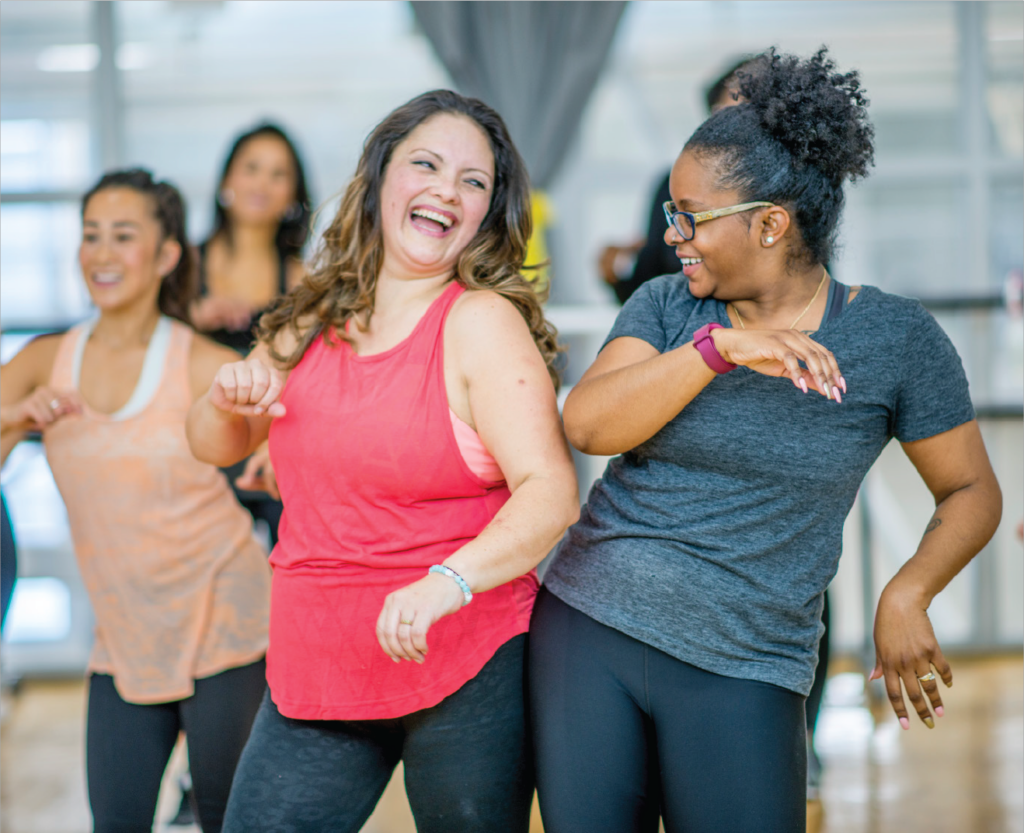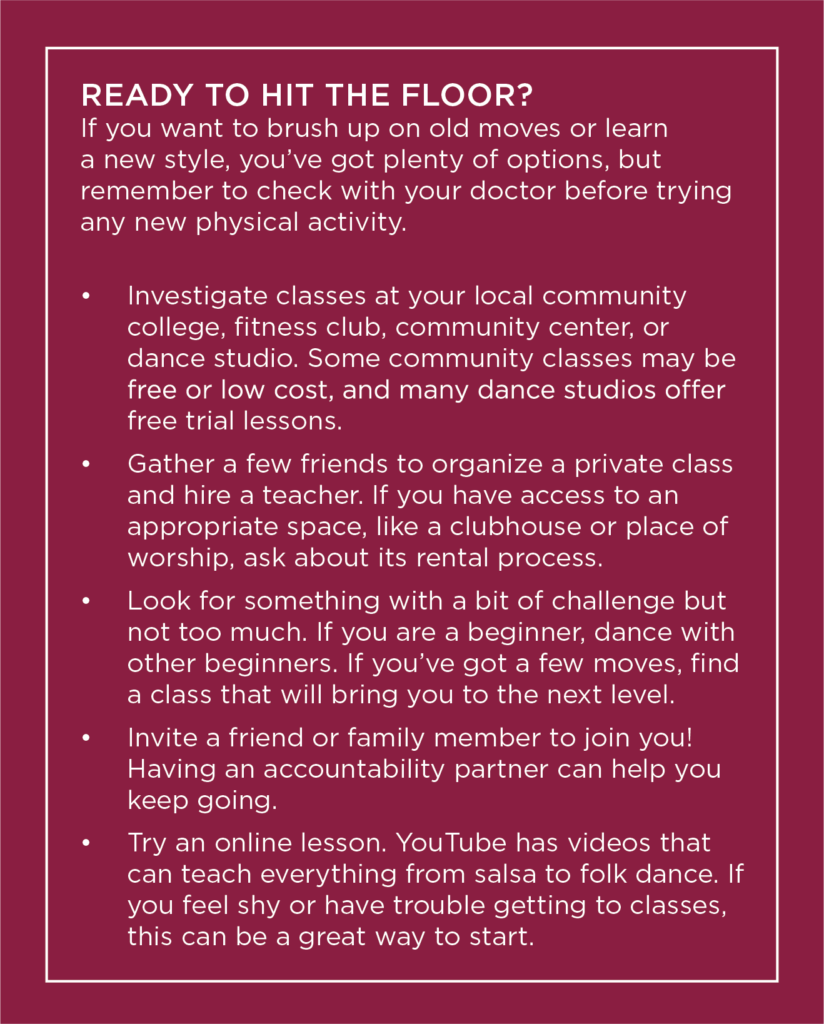4 Reasons You Should Be Dancing
Now, more than five years later, she says she’s gained a few things, including a stronger body, a brighter mood, new friends, and a lot of fun memories. Maier, now 66, entered her first ballroom dance competition just months after she started taking lessons. She says an added bonus of this new passion has been having a way to channel her considerable competitive drive.
But, Maier says, one of the best things about dance is the way it challenges her brain. “There’s always more to learn,” she says. “There’s always room to grow.”
Maier’s experience aligns with what researchers have learned about dance over the past few decades. It’s more than just a pastime or another form of exercise. From waltzes and tangos to hip-hop and country line dancing, dance has superpowers. In short, the Bee Gees were probably right: “You should be dancing.”
Why Dance?
“The secret sauce about dance is that it’s a complex activity,” says Joseph Verghese, a professor of neurology and medicine at the Albert Einstein College of Medicine in New York.
“The three main ingredients are that it has a mental component, it has a physical component, and it has a social component,” he says. Each of these, individually, has been shown to have profound effects on cognition.” Additionally, research suggests the combination of these ingredients may be greater than the sum of its parts.
Body Benefits
Like other forms of physical activity, dance builds muscle and bone, slows aging, enhances heart health, lowers blood pressure, and nudges cholesterol numbers in the right direction, according to the Harvard School of Public Health.
It also provides additional physical benefits that other forms of exercise can’t. For example, Verghese’s research shows that dance has a positive impact on stability in older adults. Other researchers have found that tango lessons specifically improve gait and balance in people with Parkinson’s disease—so much so that many people with the condition now make it a core part of their therapy.
By improving gait, stability, and balance, dance may also reduce the risk of falling. Falls are the number one cause of injury for adults 65 and older, and statistics from the Centers for Disease Control and Prevention (CDC) say that falling accounts for roughly half of all accidental deaths in this age group.

Social Connections
Dance can strengthen a person’s sense of social connection, which can lower the risk of heart disease, stroke, dementia, and depression, according to the CDC.
“You generally don’t dance alone,” says Verghese. And dancing with other people adds something special. When you move in rhythm with others, you form an “active and dynamic bond,” he says.
Having the chance to connect with others is one of the reasons why dance is so fun. It also provides accountability—making dance easier than other exercise methods to consistently show up for. “Finding something enjoyable is key,” says David Marquez, a professor of kinesiology at the University of Illinois at Chicago. And the best exercise is one you will keep doing.
Emotional Rewards
Need a mood booster? Start dancing. In some studies, dance has generated good feelings more effectively and consistently than either yoga or team sports. It has also been shown to boost energy and confidence. When we dance, our brains get dosed with endorphins—the so-called happy chemicals that reduce anxiety, depression, and pain.
Science also confirms something Maier has observed. When she’s dancing, other cares slip away. “I don’t have time to think about problems at work or anything at all,” says Maier, who runs a fireplace business with her husband. “It takes all my mental and physical attention.” When she’s dancing, Maier can be present in the moment.
An Anti-Aging Superpower
If dancing was only good for your heart, muscles, mood, and social life, it would still be a very healthy activity. But dance may also offer something more: a way to fight age-related cognitive decline.
One of the first studies to prove this connection came from Verghese and his colleagues in the 1990s. It showed that people over age 75 who engaged in certain leisure activities were less likely than their peers to develop dementia. On the list were reading, playing board games, playing musical instruments—and dancing. In fact, dancing was the only physical activity associated with a lower overall risk of dementia. (It should be noted that some other studies show brain benefits from all forms of exercise, but findings remain mixed.)

In the two decades since this study, researchers have worked to confirm the special power of dance and have found promising results. For example, Marquez investigated brain health in middle-aged and older Latinos who take Latin dance classes, learning salsa, merengue, and other steps. “The most frequent benefits we see are for memory,” he says.
Marquez and Verghese also found that dancing seems to improve executive functioning, or the skills people need to plan and meet goals. In addition, in one recent pilot study of 16 people with early signs of memory loss, Verghese found less shrinkage in one key memory-related brain area in those who had been dancing for six months compared with those assigned to treadmill walking.
What these studies don’t show is why dancing has these possible brain effects. That the movement also involved music may be a contributing factor, but Verghese points out that his treadmill walkers listened to music too.
It does seem that “dancing requires more cognitive work” than other physical activities, Marquez says. “You have to move your body to the music and remember which steps come next. And when you’re dancing with a partner, you have to be aware and reacting and keep moving with your partner.”
People who take formal dance classes also keep learning new and more difficult steps and routines. “The brain is constantly challenged by change,” Verghese says. Maier agrees. She’s advanced through several levels of competitive dancing and intends to keep aiming higher. She’s inspired, she says, by fellow dancers in their 70s, 80s, and 90s. For her, she says, dancing “is a journey that is going to last forever because you can just keep learning.”
Written By Kim Painter